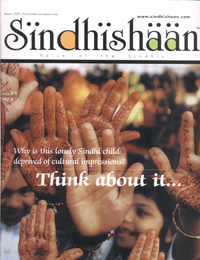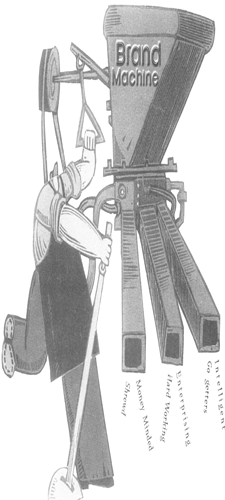THE BRAND CALLED 'SINDHI'
By Sreekanth R
A community often finds itself labeled and develops a brand image in the minds of people. South Indians are for instance branded as nerds, the Marwaris as misers and the Sindhis . . . . .
Lights, camera, action! The cameras roll over the monumental sets, characters blabber out dialogue after dialogue. There is this male character bedecked in contrasting attires, an ochre yellow blazer over his gleaming red shirt, gold chains hanging across his neck, signature of a filthy rich businessman, typical of any Bollywood movie. He is out there belting out the dialogues in an accent peculiar of Sindhi language, interspersed more often than not with a characteristic ‘Badi sayin.’ This is Mr. Bijlani, played by one of the seasoned actors of the industry. His character has negative shades in the film and hopefully if this film sees the light of the day, the masses will be exposed to another Sindhi that they will religiously relate to, given the mass-scale reach of the medium of cinema in our country.
Cut to the conference room of a small advertising firm in the capital city. The firm has just concluded their meeting with a business client who incidentally is a Sindhi gentleman. The ad-firm partners (hailing from eastern part of India) later sit across to discuss the prospects of the new acquaintance. “Seems to be a lucrative offer, but have to be wary of the guy. He’s a kattar Sindhi and will try to squeeze us out,” quips one. “We will have to be on our guard,” says the other.
Now why is it that people pass such remarks about the Sindhis. “Sindhis of course try to squeeze work out, but we are not stingy in shelling out money. And what’s wrong in working towards getting value for money?” retorts Ms Swati Rohra, who runs a computer software company.
Dr. Arjan ‘Shad’ Mirchandani in one of his literary work writes : “The impression that Sindhis are money-minded people is utterly wrong. It must be borne in mind that a majority of Sindhis all over India are actually living on a subsistence level only. It is to their credit that they try to improve their living standards by sheer hard work and intelligence.”
While there are many views pertaining to the Sindhis, one that commonly echoes is that they are hard working and shrewd businessmen. “this shrewdness and determination to excel is quality that the Sindhis owe to the history of their circumstances,” says Ms Popati Hiranandani, the renowned writer. She narrates an incident that occurred at one of the refugee camps in Northern India. Post-partition, when hordes of Sindhis crossed borders to resettle in India, they were initially posted at various refugee camps. “Every one of us used to do some odd jobs at the houses nearby the camps,” says Ms. Hiranandani. “I used to teach the children in the neighbourhood and that used to take care of my needs. There were a few others who started their own trade,” she adds. One incident that gives a striking example of the Sindhis as shrewd businessmen is the story of a matchbox salesman. During those days the Sindhis in refugee camps used to buy matchboxes for lighting their kerosene stoves from the neighbourhood grocer. The government later introduced some subsidies on the basic need, and the grocers refused to sell matchboxes alone since it wasn’t a profitable business anymore. “We had to buy a packet of bidis if we needed those matches,” recalls Ms Hiranandani. One fine morning, to the surprise of the inmates, there was this man standing at the gate of one such refugee camp announcing his offer to sell matchboxes at the cost price itself. And by evening, loads of his matchboxes were sold off. “I was amazed and was inquisitive to know how he could afford such a deal,” she says. Later it was revealed that he used to sell off the gunny bags in which the government gave the matchboxes to earn his margin. Akin to the matchbox seller, there were many other Sindhis who intelligently manoeuvred that business and earned the praise of many. It is not surprising that Sindhis are now amongst the biggest entrepreneurs in the country and the globe.
The matchbox seller is a poignant example of the shrewd business sense that the Sindhis possess. It also portrays the toil this community is willing to put up to earn its bread and butter. He never worried about the long distances he had to walk to procure the matches and later in the evening to sell his gunny bags.
Now another position that this community has attained is that of being ruthless. Ask Ms. Asha Vohra, a senior journalist and pat comes the reply, “Being straightforward is misunderstood as being ruthless. Our forefathers have faced severe hardships in the post-partition era, and what we are today is because of their perseverance and grit to take up any challenge and get ahead in life.” It is indeed a remarkable achievement that his community has arisen from deep shambles and has resurrected itself in a way that makes them true champions. So while the Sindh community on one hand has been branded as being flashy and ruthless, on the other hand has also gained the repute of being business-savvy and a hard-working lot. While positioning of a community is inadvertently communicated by the mass-scale portrayal of character in films, it is also grossly based on perceptions that individuals hold of the people of a community, a view that evolves from interactions with the people of that community.
The filmmakers must realise that it is they who are epitomic in branding the community and we hope, in future that they rise to more mature levels of characterisation of roles instead of reinforcing cliché’s.



